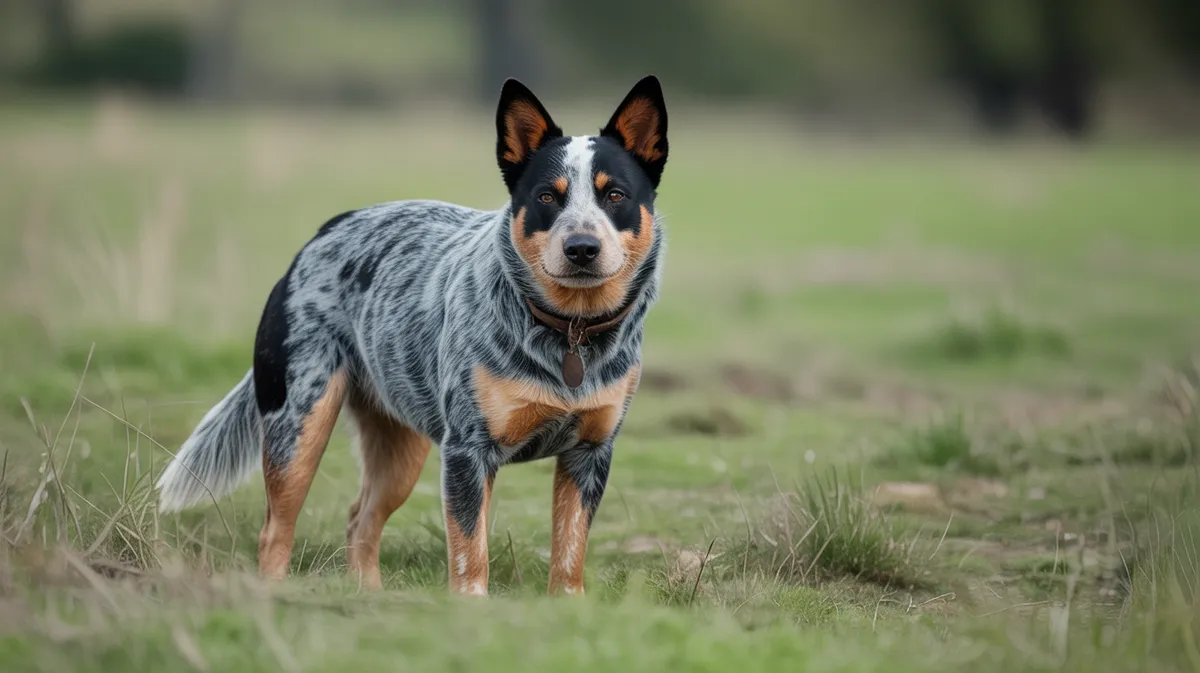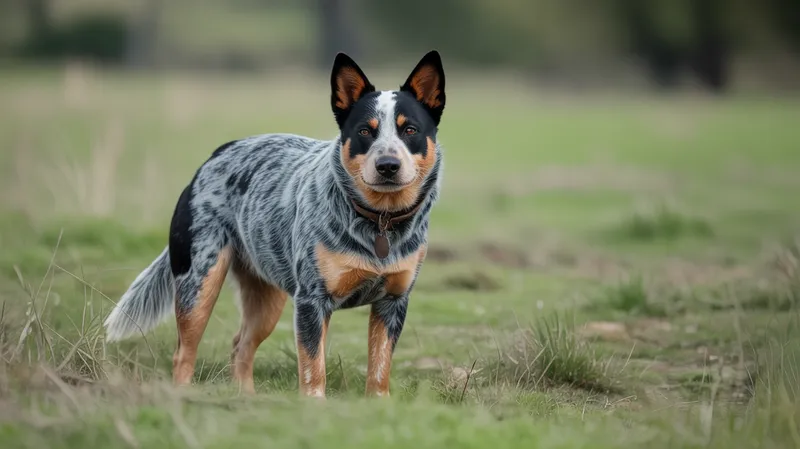
Australian Cattle Dog
Canis lupus familiaris

Meet the Australian Cattle Dog
The Australian Cattle Dog is a robust, intelligent, and energetic working breed developed in Australia for herding cattle over vast distances and challenging terrain. Known for their endurance, agility, and loyalty, these dogs have a distinctive blue or red speckled coat and upright ears. They are highly trainable, excel at obedience and canine sports, and form strong bonds with their owners. Due to their herding instinct and intelligence, they require substantial physical and mental stimulation to remain happy and healthy.
Classification
Mammal
Habitat
Grassland and farmland
Diet
Omnivore
Lifespan
12-16 years
Conservation
Least Concern
Weight
15-22 kg
📖Fascinating Facts
Exceptional Herding Skills
Australian Cattle Dogs were bred specifically to handle unruly cattle across the harsh Australian outback, making them one of the best herding breeds in the world.
Highly Alert
They have keen senses and are extremely alert, often acting as excellent watchdogs as well as working dogs.
Unique Coat Colors
Their coats come in either 'blue' (mottled or speckled with black, blue, or tan) or 'red' (speckled with red), and both color patterns are distinctive to the breed.
📋Detailed Description
The Australian Cattle Dog is a medium-sized, muscular canine, typically weighing between 15 to 22 kg (33–49 lbs) and standing 43 to 51 cm (17–20 in) at the shoulder. Its compact, sturdy frame is built for endurance and agility, enabling it to work long hours in harsh Australian environments. The breed's hallmark coat is short, dense, and weather-resistant, with distinctive 'blue' (black speckling on a white background) or 'red' (red speckling) colorations, often accompanied by characteristic facial masks and mottled markings. Australian Cattle Dogs have a broad, slightly curved skull, strong jaws, and upright, pointed ears that enhance their alertness. Their eyes are oval and dark, conveying intelligence and intensity. This breed is highly energetic, displaying remarkable stamina and a keen herding instinct, often nipping at the heels of livestock—a behavior rooted in their working heritage. Socially, they are loyal and form strong bonds with their human families, but can be wary of strangers and protective of their territory. Australian Cattle Dogs are known for their problem-solving abilities, adaptability, and capacity for independent decision-making in the field. Reproduction is typical of medium-sized dogs, with litters averaging 5–7 puppies, and both parents may exhibit protective behaviors toward offspring. Their unique combination of physical robustness, intelligence, and tenacity makes them exceptional working dogs and devoted companions.
💡 Did you know?
An Australian Cattle Dog named Bluey holds the verified record for the oldest dog ever, living to 29 years and 5 months.
🔬Research & Sources
Wikipedia Summary
The Australian Cattle Dog, or simply Cattle Dog, is a breed of herding dog developed in Australia for droving cattle over long distances across rough terrain. This breed is a medium-sized, short-coated dog that occurs in two main colour forms. It has either red or black hair distributed fairly evenly through a white coat, which gives the appearance of a "red" or "blue" dog.
Last Modified: 5/26/2025
🎭Behavior & Social Structure
Australian Cattle Dogs are highly active and thrive on regular physical and mental stimulation. Their daily routines often include vigorous exercise, such as running, agility training, or herding tasks. They display strong herding behaviors, including circling, stalking, and heel-nipping, which can sometimes be directed at people or other animals if not properly channeled. These dogs are highly trainable, excelling in obedience, agility, and canine sports, but require consistent, positive reinforcement and clear leadership. Socially, they are typically reserved with strangers but deeply loyal to their families, often forming a close bond with a single person. They are alert and protective, making them effective watchdogs. Feeding behavior is typical of domestic dogs, but their high energy demands require a nutrient-rich diet. Without sufficient activity and engagement, they may develop behavioral issues such as destructiveness or excessive barking.
👶Reproduction & Life Cycle
Australian Cattle Dogs reach sexual maturity between 6 and 12 months, though responsible breeding is recommended after 18 months of age. The breed does not have a strict breeding season and can mate year-round. The gestation period averages 63 days. Litters typically consist of 5 to 7 puppies, though larger litters are possible. Females exhibit strong maternal instincts, providing attentive care, warmth, and protection to their young. Puppies are born with a white coat, developing their characteristic blue or red speckling as they mature. Early socialization and exposure to various stimuli are crucial for behavioral development. Both parents may display protective behaviors, but primary care is provided by the dam.
🛡️Adaptations & Survival
The Australian Cattle Dog's physical adaptations include a dense, weather-resistant double coat that protects against harsh sun, rain, and cold. Their compact, muscular build and well-angled limbs provide agility and stamina for traversing rugged terrain and covering long distances. The breed's keen senses—especially acute hearing and vision—aid in detecting livestock and potential threats. Behaviorally, their strong herding instinct, intelligence, and independent problem-solving skills are evolutionary specializations for managing large herds with minimal human direction. Their tendency to nip at heels is an inherited behavior from their dingo ancestry, refined for effective cattle control. High energy levels and endurance allow them to work tirelessly throughout the day.
📚Research Sources
🎨Cultural Significance
The Australian Cattle Dog holds a prominent place in Australian rural culture, symbolizing resilience, intelligence, and hard work. Developed in the 19th century by crossing native Dingoes with imported herding breeds (such as Collies and Dalmatians), the breed was instrumental in the expansion of Australia's cattle industry. It is featured in Australian folklore, literature, and media, and is sometimes referred to as the 'Blue Heeler' or 'Red Heeler' based on coat color. The breed is celebrated for its loyalty and has been the subject of various working dog competitions and exhibitions. Statues and monuments in rural towns commemorate their contribution to Australian agriculture.
🔬Recent Research & Discoveries
Recent genetic studies have confirmed the breed's dingo ancestry, providing insight into its unique behavioral and physical traits. Ongoing research focuses on inherited health conditions, particularly hereditary deafness and PRA, with DNA testing now available for breeders. Studies on canine cognition have highlighted the Australian Cattle Dog's advanced problem-solving skills and trainability. Behavioral research emphasizes the importance of early socialization and structured activity to prevent the development of undesirable behaviors. There is also interest in their role as service and therapy dogs, given their intelligence and adaptability.
🎥Wildlife Videos

From Outback to Outdoors: The Remarkable Story of the Australian Cattle Dog
Join us on a fascinating journey through the history of the Australian Cattle Dog, a breed that epitomizes resilience, adaptability, ...
Pets Got Blog

Breed All About It - Australian Cattle Dog
The Australian cattle dog is known for its high intelligence and loyalty.
Animal Planet

7 REASONS WHY THE BLUE HEELER IS THE TOUGHEST DOG BREED
BLUE HEELER IS THE TOUGHEST DOG BREED. Welcome to our channel! In this video, we'll be discussing the Blue Heeler, ...
Dogs Now

Wildlife - Just Wild Dogs | Free Documentary Nature
Wildlife - Episode 7: Just Wild Dogs | Wildlife Documentary Watch 'Wildlife - Episode 8' here: https://youtu.be/kglJpB4ei8o Run ...
Free Documentary - Nature

The Australian Cattle Dog - Burke's Backyard
Red Heeler" or "Blue Heeler.
Geckos and Gum Leaves

Blue Heeler (Australian Cattle Dogs) 101: Everything You Need to Know
Welcome to our Blue Heeler Dogs 101 guide! Whether you're a proud Blue Heeler owner, thinking about adopting one, or just ...
Dogs Now
🌍Habitat Information
The Australian Cattle Dog typically inhabits Grassland and farmland environments. Australian Cattle Dogs have adapted to their environments with specialized features and behaviors.
Primary Habitat:
Grassland and farmland
More detailed habitat information will be available soon.
🛡️Conservation Status
The Australian Cattle Dog is currently classified as Least Concern. Conservation efforts are crucial for preserving this species for future generations.
Common Threats:
- 🏠Habitat loss and fragmentation
- 🌡️Climate change impacts
- 🎯Hunting and poaching
- 🏭Human-wildlife conflict
⚠️Threats & Conservation Challenges
As a domestic breed, the Australian Cattle Dog is not considered at risk in terms of population, and is classified as 'Least Concern.' However, challenges include genetic health issues such as progressive retinal atrophy, hip dysplasia, and congenital deafness, particularly in dogs with excessive white pigmentation. Modern lifestyle changes and urbanization can lead to under-stimulation and behavioral problems if their exercise and mental needs are not met. Overbreeding and irresponsible breeding practices may also contribute to health and temperament issues. While not threatened in the wild, the breed's working role is diminishing in some regions due to mechanization of agriculture.
🔬Scientific Classification
Scientific Name
Canis lupus familiaris
Classification Hierarchy
🔍 About Taxonomic Classification
Taxonomic classification is a hierarchical system used by scientists to classify and organize living organisms based on shared characteristics and evolutionary relationships.
The system moves from broad categories (Kingdom) to increasingly specific ones, with each animal's scientific name typically consisting of its Genus and species.
📝Community Notes
Share your observations and insights about the Australian Cattle Dog with our community of wildlife enthusiasts.
Join Our Community
Sign in to share your observations and connect with fellow wildlife enthusiasts.
Sign In to ContributeNo community notes yet
Be the first to share your observations about the Australian Cattle Dog!
Explore Australian Cattle Dog
Select a tab above to learn more about this amazing animal.
📸Photo Gallery
No photos available for this animal yet.
🌟Discover More Wildlife
Continue your journey of discovery with more fascinating animals from our database
